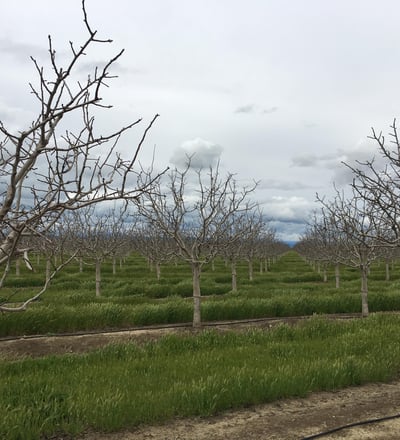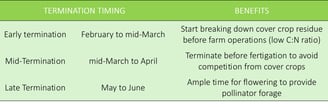Terminating Winter Cover Crops in Orchard Systems
by Jonathan Rodriguez and Douglas Amaral @ University of California Cooperative Extension


Cover crops and resident vegetation can provide enhanced agronomic and ecosystem benefits to California orchards.
Termination timing and method
Due to complex interactions, the decision on termination timing must be site and situation specific and should consider several factors. Therefore, the timing of cover crop termination should align with specific grower goals. There are advantages to different approaches, early termination favors biomass breakdown without excessive accumulation, while later termination provides pollinator forage for crops. In addition, termination methods for cover crops can be chemical or mechanical, or a combination of the two.
Growers face several challenges on their farms which demand management strategies to improve productivity and sustainability. One beneficial tool is the use of cover crops. This can improve soil quality, reduce erosion, and improve pest management. After planting and growth, termination should follow from February to mid-June. This will lead to post-termination in which mowing may be done to control weeds and residue.
Timing for termination will depend on the specific goals you hope to accomplish and the opportunities and constraints of your operation.


Techniques such as mowing effectively manage crop residues; however, the age and biomass of the cover crops may complicate this process. High mowing may also limit the flowering potential of the cover crop, reducing bee forage but can help prevent cover crop biomass from becoming hard to manage. For most growers, termination of cover crops will require to repeat the process three-to-five times between termination and harvest. Most growers will use flail mowers or rotary mowers.
Herbicides can also be an option but must be used cautiously near harvest time to limit herbicide residues especially on harvested crops. Understanding what cover crops and weed species are in a particular location will be important to choose an appropriate herbicide. Many growers have reported that the use of herbicides after mowing is unnecessary. Consult a licensed pest control adviser for any chemical pesticide use.
Consider using tillage for integrating cover crops into the soil which is favorable for nematode suppression and nutrient management - to reduce nitrogen losses from volatilization, and to speed decomposition and nitrogen release from biomass. It is important to note that excessive tillage can negatively impact soil structure and the microbial processes that drive decomposition reduce the opportunity for carbon accrual.
C:N Ratio and the Nitrogen cycle
The carbon-to-nitrogen (C:N) ratio is a measure of the mass of carbon to the mass of nitrogen in a substance, which can significantly impact soil functions such as crop residue decomposition and nutrient cycling, particularly nitrogen cycling. Therefore, the C:N ratio of the cover crop at termination influences whether nitrogen will be immobilized or released. Mineralization or release of nitrogen occurs when the C:N ratio is below 20:1, while immobilization or sequestering of nitrogen usually occurs when the C:N ratio is above 25:1. Cover crop residues with very high C:N ratios may also immobilize some soil nitrogen.
Early termination of grass cover crops may result in a smaller amount of residue with a low C:N ratio resulting in rapid decomposition and limited ground coverage. C:N ratio usually exceeding 30:1 may result in an initial immobilization of nitrogen during the growing season. The C:N ratio of mature legume residues varies from 9:1 to 25:1 and is typically below 20:1. The lower C:N ratio of legumes allows for rapid release of nitrogen but limits the persistence of their residues in the field. The nitrogen contribution to the following crop from small grains depends on nitrogen availability during cover crop growth, the total biomass produced, and the growth stage and C:N ratio at termination.
After termination of cover crops while they are vegetative will allow for rapid decomposition. This could involve watering areas with macerated residues to expedite breakdown. Regular mowing may require post-termination to maintain a clean orchard and prepare for the next crop cycle. The cover crop management practices described in this article are the most common cover cropping strategies, but there are many options to achieve your goals and increase orchard biodiversity.
